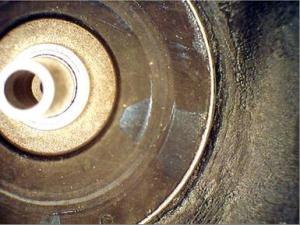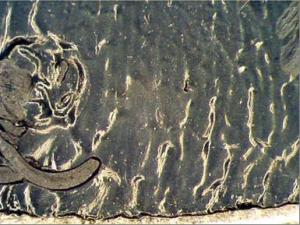Polymeric O-ring Identification
Gideon Analytical Laboratories received three contaminated Buna-N diaphragms and several new ones for reference. These Buna-N diaphragms have a variety of applications, including in submersible level transmitters, actuary assemblies, air operated diaphragm pumps, and manual loading regulators. The goal was to identify the contamination and pinpoint its cause.
Upon examination under a stereo-zoom microscope, it was found that the surface of the sample contains a thick layer of a gel-like material. The gel had a brown tincture and fluoresced under black light. All three diaphragms were contaminated with this gel, which is pictured at the top left. The material from two patches of white material on the surface of the sample was removed and analyzed using FTIR. The white material can be seen pictured at the top right. The samples are similar to one another and showed absorptions due to fumed silica or amorphous silica with a small amount of the gel material seen in other samples.
The FTIR analysis revealed that the gel material of the first sample consisted mainly of a poly(fluorocarbon) with some aliphatic hydrocarbon oil and a small amount of silica. The white material on the second sample was mainly fumed silica or amorphous silica with a small amount of gel material as seen in the first sample. Gideon Analytical Laboratories concluded then, that the poly fluorocarbon and aliphatic hydrocarbon did not leach from the Buna-N rubber, instead, they are external contaminants.
With the aid of failure analysis performed by Gideon Analytical Laboratories, companies in the electronics industry can rest assured that they know exactly why and how devices are failing. This invaluable knowledge can help not only save companies enormous amounts of time and money but help them plan for future business. The main goal of failure analysis by Gideon Analytical Laboratories is to help companies solve problems.

White aliphatic contaminate

Gel-like contaminate